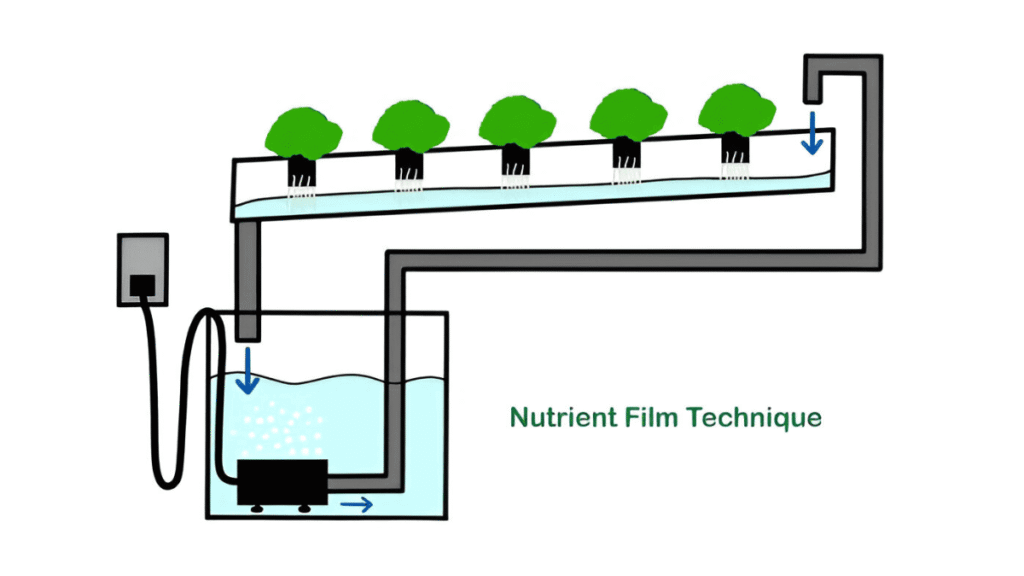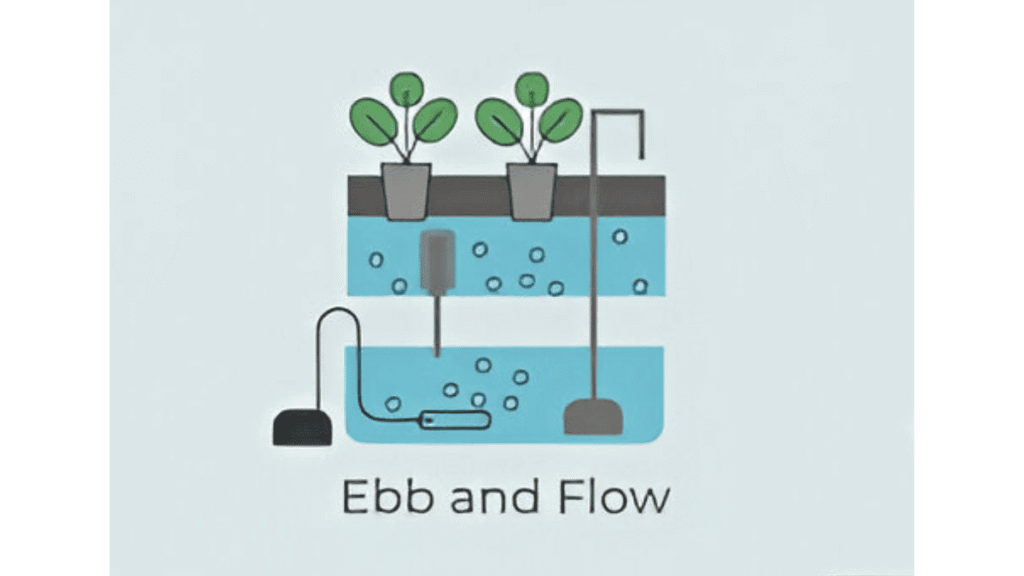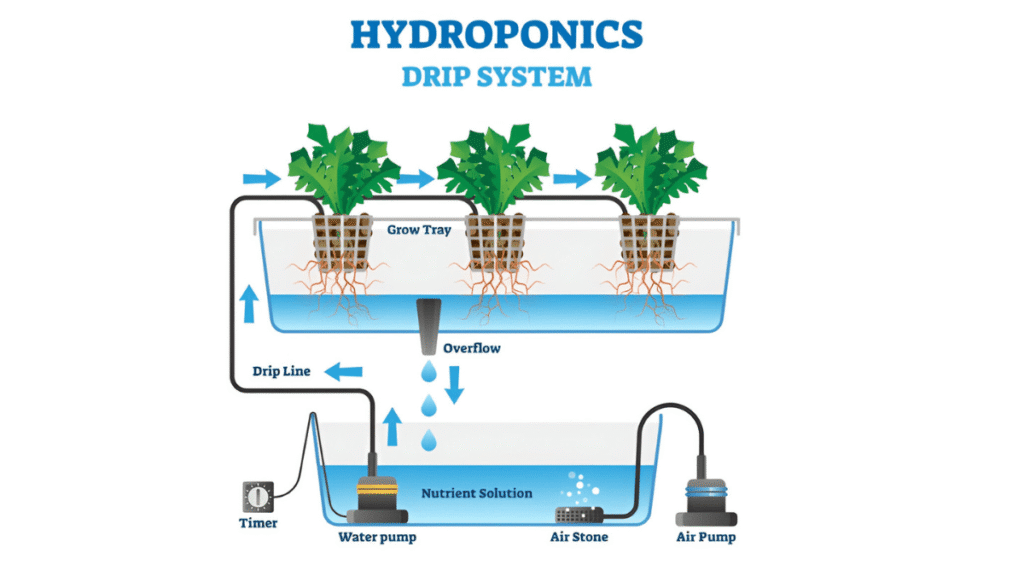As the world’s population rises and arable land shrinks, the pressure on traditional agriculture has never been greater. Hydroponic farmin a soil-free, resource-efficient method that is revolutionizing how we grow food. Whether you’re an urban dweller, a tech enthusiast, or a sustainability advocate, hydroponics offers a glimpse into the future of farming.
What is Hydroponic Farming?
Hydroponics derives its name from the Greek words “hydro” (water) and “ponic” (labor), meaning “working water”. In hydroponic systems, plants are grown in nutrient-rich solutions, sometimes supported by inert media such as perlite, coconut coir, vermiculite, or gravel, rather than traditional soil. The technique is used by hobbyists, small farmers, and large commercial operations alike.
How Does Hydroponics Work?

Hydroponic farming is a method of growing plants without soil, using water enriched with mineral nutrients to provide all the essential elements that plants need for growth. Instead of relying on soil as a reservoir for nutrients, hydroponic systems deliver a nutrient-rich solution directly to the plant roots, often using inert mediums like rockwool, perlite, or coconut coir to anchor the plants.
Hydroponic systems allow precise control over environmental factors such as temperature, light, pH, and nutrient concentration, which accelerates plant growth and increases yields. By eliminating soil, hydroponics reduces the risk of soil-borne diseases and pests, and minimizes the unpredictability associated with traditional outdoor farming. Aeration is also crucial; many systems use air pumps or ensure that part of the root system is exposed to air to supply adequate oxygen.
There are several types of hydroponic systems, including Deep Water Culture (DWC), Nutrient Film Technique (NFT), Ebb and Flow (Flood and Drain), Drip Systems, and Wick Systems. Each system uses a different method to deliver water, nutrients, and oxygen to the plant roots, but all share the goal of optimizing plant health and productivity in a controlled, soilless environment.
Types of Hydroponic Systems
Deep Water Culture (DWC)

Deep Water Culture (DWC) is a popular hydroponic farming method where plant roots are suspended directly in a reservoir of nutrient-rich, well-oxygenated water. An air pump and air stone are used to continuously oxygenate the water, ensuring the roots receive both nutrients and ample oxygen. Plants are typically supported in net pots or floating rafts, allowing their roots to dangle freely into the solution.
This system is known for its simplicity and effectiveness, making it accessible for home growers and commercial producers alike. DWC provides a stable environment for plant growth, as the large water volume helps buffer temperature and nutrient fluctuations. It is especially well-suited for fast-growing, short-term crops like leafy greens and herbs, enabling rapid growth and high yields.
Nutrient Film Technique (NFT)

Nutrient Film Technique (NFT) is a hydroponic growing method where plants are grown in shallow channels or gullies, and their roots are continuously bathed in a thin, recirculating film of nutrient-rich water. The system uses a water pump to circulate the nutrient solution from a reservoir through the channels, ensuring that the plant roots receive a constant supply of water, nutrients, and oxygen. The channels are set at a slight angle, allowing gravity to help the solution flow smoothly and return to the reservoir for reuse.
In NFT, the roots are partially exposed to air, which enhances oxygen uptake, while the lower part of the roots absorbs nutrients from the flowing solution. This design makes NFT highly efficient in water and nutrient use and supports rapid plant growth. However, because the nutrient film is shallow, the system is sensitive to interruptions in flow—any pump failure can quickly lead to plant stress or death.
Ebb and Flow System

The Ebb and Flow system, also known as Flood and Drain, is a hydroponic method that periodically floods plant roots with a nutrient-rich solution and then drains it away. In this system, plants are typically placed in pots filled with a growing medium such as perlite, coconut coir, or soil, which are set in a watertight tray or container. A pump, controlled by a timer, floods the tray with the nutrient solution, saturating the roots and medium. After a set period, the solution drains back into a reservoir, allowing the roots to access oxygen until the next cycle begins. This cyclic process of flooding and draining mimics natural irrigation cycles, promotes healthy plant growth, and provides plants with periodic nutrient replenishment and aeration.
Drip System

A Drip System is an active hydroponic method that uses a pump to deliver a nutrient-rich water solution directly to the root zone of each plant through a network of tubes and small emitters, often called drippers or micro-irrigation devices. The emitters slowly drip the solution onto the growing medium surrounding the plant roots, providing precise and targeted irrigation.
This system allows for high control over the amount of water and nutrients each plant receives, making it suitable for a wide variety of crops and especially favored in larger or commercial hydroponic operations. Drip systems can be set up as either recirculating (where excess solution drains back to the reservoir for reuse) or non-recirculating (where excess is discarded). The slow, controlled delivery minimizes water waste and supports efficient nutrient uptake, while automation with timers and sensors can further enhance convenience and consistency.
Wick System

The Wick System is a passive hydroponic method where plants receive water and nutrients through a wick that draws solution from a reservoir up to the plant roots using capillary action. In this setup, plants are grown in containers filled with a growing medium such as perlite, coconut coir, or vermiculite. One or more wicks—made from absorbent materials like cotton, nylon, or felt—extend from the plant container into a reservoir containing the nutrient solution.
As the growing medium and plant roots dry out, the wick continuously pulls nutrient-rich water from the reservoir to the roots, maintaining consistent moisture and nutrient levels without the need for pumps or electricity. This simplicity makes the Wick System ideal for beginners and best suited for small, low-water-demand plants like herbs and lettuce.
Aeroponics

Aeroponics is a soilless method of growing plants in which the roots are suspended in the air and periodically misted with a nutrient-rich solution. Unlike traditional hydroponics, where roots are submerged in water or an inert medium, aeroponics exposes the roots directly to the air, delivering nutrients through a fine spray or mist. This setup provides the roots with abundant oxygen, promoting faster growth, higher yields, and efficient nutrient absorption. Aeroponics systems typically consist of a root chamber, a reservoir for the nutrient solution, a pump, and misting nozzles or foggers that atomize the solution onto the roots at regular intervals. This technique uses less water than other hydroponic methods and minimizes the risk of soil-borne diseases, but it requires precise control and maintenance to prevent clogging and ensure consistent misting.
Components of Hydroponic System
A successful hydroponic system relies on several essential components, each playing a specific role in supporting healthy plant growth:
- Growing Chamber or Tray:
The structure where plants are placed, often perforated to allow roots to access the nutrient solution. It provides support and protects plants from environmental stress. - Reservoir:
A container that holds the nutrient solution. It should be light-proof to prevent algae and microbial growth, ensuring the solution remains clean and effective. - Nutrient Solution:
The lifeblood of hydroponics, this is a carefully balanced mix of water and essential minerals (e.g., nitrogen, phosphorus, potassium, calcium, magnesium, iron, manganese, zinc) tailored to plant needs. Regular monitoring and adjustment are crucial for optimal growth. - Water:
Acts as the medium for nutrient delivery. Water quality, pH, dissolved oxygen, and temperature must be managed to maintain plant health. - Submersible Pump:
Circulates the nutrient solution from the reservoir to the plant roots, ensuring even distribution and preventing stagnation. - Delivery System (Tubes/Pipes):
Channels or pipes that transport the nutrient solution to the plants, similar to arteries in a circulatory system. - Air Pump and Air Stones:
Supplies oxygen to the nutrient solution, preventing root suffocation and promoting healthy growth, especially in systems where roots are submerged. - Growing Medium:
An inert material (such as perlite, coconut coir, or rockwool) that anchors plant roots and helps distribute water and nutrients evenly. - Grow Lights:
Provide the necessary light spectrum for photosynthesis, especially in indoor or controlled environments. LED grow lights are commonly used for their efficiency and adjustable wavelengths. - Timer:
Automates essential functions like nutrient delivery and lighting cycles, ensuring consistency and optimal growth conditions. - pH Meter and Adjusters:
Monitor and regulate the pH of the nutrient solution, keeping it within the ideal range for nutrient absorption. - Support Structures:
Trellises, stakes, or netting to keep plants upright and stable, especially for taller or fruit-bearing varieties. - Ventilation and Air Circulation:
Fans or ventilation systems regulate temperature, humidity, and CO₂ levels, creating an optimal environment for plant development.
Each of these components works together to create a controlled, efficient, and productive environment for soilless plant cultivation.
Which plants can be grown in a Hydroponic system?
A wide variety of plants can be successfully grown in hydroponic systems, making this method popular for both home gardeners and commercial producers. Here are some of the most common and best-suited plants for hydroponic cultivation:
Leafy Greens
- Lettuce (including butterhead, romaine, and baby lettuce)
- Spinach
- Kale
- Swiss chard
- Arugula
- Mustard greens
- Collard greens
Herbs
- Basil
- Parsley
- Cilantro
- Mint
- Dill
- Chives
Fruiting Vegetables
- Tomatoes
- Peppers (bell and chili)
- Cucumbers
- Eggplant
- Strawberries
Flowers and Ornamentals
- Marigold
- Nasturtium
- Petunia
- Moss rose
Specialty and Exotic Crops
- Amaranth
- Lemon balm
- Cardoon
- Endive
Key Points:
- Leafy greens and herbs are especially well-suited to hydroponics due to their fast growth and shallow root systems.
- Fruiting crops like tomatoes, peppers, and strawberries can also thrive, especially with proper system support and pollination.
- Some root vegetables (like radishes) and certain flowers can be grown hydroponically, though they may require specific system adjustments.
Matching your plant selection to the type of hydroponic system and available space will help ensure healthy growth and high yields.
Advantages of Hydroponic Farming
Hydroponic farming offers numerous benefits over traditional soil-based agriculture, making it an increasingly popular choice for growers worldwide. Key advantages include:
- Higher Yields and Faster Growth:
Plants in hydroponic systems typically grow 30–50% faster and produce higher yields because they receive optimal nutrients and oxygen directly to their roots, with less environmental stress. - Water Conservation:
Hydroponics uses up to 90% less water than conventional farming. The nutrient solution is recirculated, minimizing waste and making this method highly efficient in water-scarce regions. - Space Efficiency:
Plants can be grown closer together since their roots do not need to spread out in search of nutrients. This allows for higher plant density and is ideal for urban, vertical, or rooftop farming. - Year-Round Cultivation:
By controlling environmental factors such as temperature, light, and humidity, hydroponic systems enable growers to produce crops throughout the year, regardless of external weather or season. - Reduced Pest and Disease Pressure:
The absence of soil eliminates many soil-borne diseases and pests. Indoor or greenhouse hydroponics further reduces the risk of infestations, leading to healthier plants and less need for pesticides. - Precise Nutrient and Environmental Control:
Growers can tailor nutrient solutions and environmental conditions to the specific needs of each crop, resulting in healthier plants and more consistent quality. - Less Use of Chemicals:
With fewer pests and diseases, hydroponic farms generally require less pesticide and herbicide use, making produce safer and more environmentally friendly. - Reduced Soil Erosion and Environmental Impact:
Hydroponics eliminates soil erosion and runoff, minimizing negative environmental effects and allowing farming in areas with poor or contaminated soils. - Ease of Harvesting:
Plants are often grown at waist height, making harvesting easier and more accessible, especially for those with limited mobility.
These advantages make hydroponic farming a sustainable, efficient, and productive alternative to traditional agriculture, especially in areas with limited land or water resources.
Challenges and Disadvantages of Hydroponic Farming
While hydroponic farming offers many benefits, it also presents several challenges and disadvantages that growers should consider:
- High Initial Setup Costs:
Establishing a hydroponic system requires significant investment in infrastructure, including water treatment, nutrient tanks, pumps, lighting, climate control, and monitoring equipment. This can be a barrier for small-scale or new entrants. - Dependence on Electricity:
Hydroponic systems rely heavily on a constant power supply to run pumps, lights, and climate controls. Power outages or interruptions can quickly harm or kill plants, making backup systems or renewable energy sources important considerations. - Intensive Monitoring and Maintenance:
Unlike traditional farming, hydroponics demands regular and precise monitoring of nutrient levels, pH, temperature, and equipment functionality. Any lapse in maintenance can lead to rapid plant stress or system failure. - Technical Expertise Required:
Successful hydroponic farming requires specialized knowledge and skills. Growers must understand system operation, nutrient management, and troubleshooting, which can be a steep learning curve for beginners. - Risk of Waterborne Diseases:
While soil-borne diseases are minimized, hydroponic systems are susceptible to waterborne pathogens. Diseases can spread rapidly through the circulating nutrient solution, potentially affecting all plants in the system. - Environmental and Operational Concerns:
Hydroponic farming can consume large amounts of energy, especially for indoor or vertical farms using artificial lighting and climate control. Improper disposal of nutrient solutions can also pose environmental risks if not managed responsibly. - System Vulnerability:
Because there is no soil buffer, plants react quickly to problems such as nutrient imbalances, equipment failure, or contamination. Issues can escalate rapidly, leading to crop loss if not addressed promptly. - Limited Crop Diversity:
Not all crops are equally suited to hydroponic systems. While leafy greens, herbs, and some fruits thrive, root vegetables and large fruiting plants may be more challenging to grow.
These challenges mean that while hydroponic farming is innovative and efficient, it requires careful planning, ongoing attention, and a willingness to invest in both technology and expertise to be successful.
Conclusion
Hydroponic farming represents a modern, efficient, and sustainable approach to agriculture, allowing growers to cultivate a wide range of crops without soil by using nutrient-rich water solutions. This method offers significant advantages, including faster plant growth, higher yields, and reduced water usage, making it especially appealing in urban environments or areas with limited arable land.
Getting started with hydroponics involves selecting the right system, understanding the needs of your chosen crops, and maintaining careful control over nutrients, pH, and environmental conditions. Consistent monitoring, regular cleaning, and diligent record-keeping are essential for long-term success and productivity.
While hydroponic farming requires an initial investment and ongoing attention, it provides opportunities for year-round production and helps address challenges related to traditional agriculture, such as soil degradation and water scarcity. With proper planning and maintenance, hydroponics can be a rewarding and scalable solution for both hobbyists and commercial growers.

